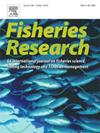Biological, economic and social viability of a mesopelagic fishery in the Bay of Biscay
IF 2.3
2区 农林科学
Q2 FISHERIES
引用次数: 0
Abstract
A recently estimated high mesopelagic biomass level, along with the increasing demand for raw material for fish oil and fishmeal, has sparked interest on exploiting mesopelagic populations. However, their exploitation is controversial due to their ecological role as primary prey for other populations and as CO2 sequestrators. Therefore, before starting a new fishery, the three pillars of sustainability, ecological, economic and social, should be assessed. In the Bay of Biscay Maurolicus muelleri is the main mesopelagic species. Based on data collected over an eight-year period, a simulation model was implemented to assess the biological, economic and social performance of different fleets and exploitation levels. The conditioning of the population dynamics model presented several challenges, as the available survey index did not cover the full population distribution every year and the population had never been exploited in the Bay of Biscay. To overcome these problems an absolute population index was estimated using a spatio-temporal model, which was later used to adjust an age structured population dynamics model. Both models were fitted using Bayesian statistics to account for inherent uncertainty. The fishery was conditioned by identifying the most suitable fleet and estimating the initial investment and operational costs. The social pillar was approached through the social cost of carbon. The estimated biomass of M. muelleri in the Bay of Biscay fluctuated around 1.2 million tonnes. When it comes to exploitation, an industrial fishery may generate profits while maintaining a sustainable biomass level under good efficiency conditions. However, it would be challenging to recover the initial investment. Additionally, the estimated added value generated by this fishery would not be able to compensate for public costs associated with the impacts on carbon sequestration.
比斯开湾中远洋渔业的生物、经济和社会可行性
最近估计中上层生物的生物量水平很高,加上对鱼油和鱼粉原料的需求不断增加,引起了人们对开发中上层种群的兴趣。然而,由于它们作为其他种群的主要猎物和二氧化碳封存者的生态作用,它们的开发是有争议的。因此,在开始新的渔业之前,应评估可持续性的三大支柱,即生态、经济和社会。在比斯开湾,Maurolicus muelleri是主要的中远洋物种。基于8年收集的数据,实施了一个模拟模型来评估不同船队和开发水平的生物、经济和社会绩效。由于现有的调查指数没有覆盖每年的全部种群分布,而且比斯开湾从未开发过种群,因此对种群动态模型的调节提出了若干挑战。为了克服这些问题,利用时空模型估计绝对人口指数,然后将其用于调整年龄结构人口动态模型。两个模型都使用贝叶斯统计来解释固有的不确定性。渔业的条件是确定最合适的船队并估计初始投资和业务成本。通过碳的社会成本来探讨社会支柱。比斯开湾muelleri m.s umelleri的估计生物量在120万吨左右波动。在开发方面,工业化渔业可以产生利润,同时在良好的效率条件下保持可持续的生物量水平。然而,收回初始投资将是一项挑战。此外,这种渔业产生的估计附加值将无法补偿与碳封存影响有关的公共成本。
本文章由计算机程序翻译,如有差异,请以英文原文为准。
求助全文
约1分钟内获得全文
求助全文
来源期刊

Fisheries Research
农林科学-渔业
CiteScore
4.50
自引率
16.70%
发文量
294
审稿时长
15 weeks
期刊介绍:
This journal provides an international forum for the publication of papers in the areas of fisheries science, fishing technology, fisheries management and relevant socio-economics. The scope covers fisheries in salt, brackish and freshwater systems, and all aspects of associated ecology, environmental aspects of fisheries, and economics. Both theoretical and practical papers are acceptable, including laboratory and field experimental studies relevant to fisheries. Papers on the conservation of exploitable living resources are welcome. Review and Viewpoint articles are also published. As the specified areas inevitably impinge on and interrelate with each other, the approach of the journal is multidisciplinary, and authors are encouraged to emphasise the relevance of their own work to that of other disciplines. The journal is intended for fisheries scientists, biological oceanographers, gear technologists, economists, managers, administrators, policy makers and legislators.
 求助内容:
求助内容: 应助结果提醒方式:
应助结果提醒方式:


